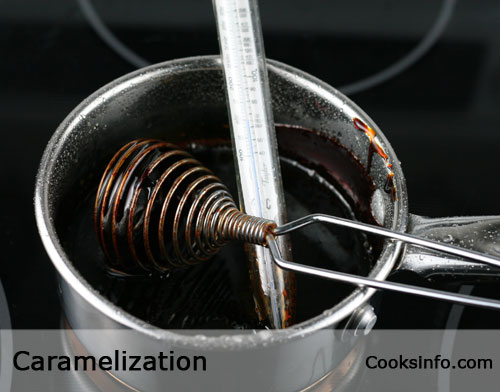 Caramelization
Caramelization© Randal Oulton
Caramelization (strictly speaking) is the process of sugar turning brown through heat being applied. Water may or may not be added.
To Caramelize is the process of causing caramelization to happen.
It can be done with sugar, by adding sugar, or working with the sugars naturally already in a food item.
In addition to the change in colour, the flavour changes as the simple compounds in the sugars break down, and new ones are formed. What gives caramel a buttery taste and scent is one of the new compounds formed as a result of heating, called “biacetyl”(C4H6O2.) The other new compounds formed are a range of sour, bitter and sweet tastes, which gives caramel its complexity on the palate.
Different types of sugar caramelize at different rates, depending on how much fructose, glucose, etc, the actual sugar is made of. Fructose, for instance, caramelizes faster than glucose. Honey, which has more fructose in it than does white table sugar (which is fructose and glucose), will therefore caramelize faster than table sugar.
Caramelization generally happens after water is gone from a sugar substance, because water limits the temperature to 100 C (212 F.) However, it can start occurring where surface contact makes the immediate area hotter (e.g. the bottom of a pot.)
White table sugar starts to caramelize between 155 C to 182 C (310 F to 360 F.) When it reaches 180 C (356 F), it’s light caramel.
|
Celsius
|
Fahrenheit
|
Stage | Characteristics | ||
|
100
|
212
|
All water will evaporate | Sugar is melted and impurities rise to the surface. | ||
|
102
|
215
|
Small thread | No colour or flavour change; cools soft. | ||
|
104
|
219
|
Large thread | No colour or flavour change; cools soft. | ||
|
110 to 115
|
230 to 240
|
Small ball | No colour or flavour change; cools somewhat soft. | ||
|
119 to 122
|
246 to 252
|
Large ball | No colour or flavour change; cools firm. | ||
|
130
|
264
|
Light crack | No colour or flavour change; cools firm. | ||
|
149 to 166
|
300 to 331
|
Hard crack | No colour or flavour change; cools hard. | ||
|
168
|
334
|
Extra hard crack | Slight colour change; no flavour change; brittle when cooled. | ||
|
180
|
356
|
Light caramel | Colour becomes amber; flavour becomes rich. | ||
|
180 to 188
|
356 to 370
|
Medium caramel | Colour becomes darker amber; flavour becomes rich. | ||
|
188 to 204
|
370 to 400
|
Dark caramel | Colour becomes very dark. Bitter taste, burnt aroma. | ||
|
210
|
410
|
Black Jack (aka Baker’s Caramel) | Colour becomes extremely dark and tastes very burnt. No sweet taste left. |
In classical French cooking, caramelization can be done in several ways:
-
- sprinkling sugar on the surface on an item, and put it under intense heat for a brief period;
- transforming sugar into caramel by cooking it slowly without stirring;
- pouring caramel over an item;
- coating the interior of a mould with caramel.
Many reactions in the kitchen are described as caramelization, but are actually a maillard reaction, which is a reaction between sugars and protein. This is not as the same as caramelization, which concerns itself strictly with the interaction of sugars and heat.
And, however educated one can be about the science of caramelization and how to make it happen and why it is happening, it still remains a challenge to stop it from happening sometimes, such as when you are making peach jam, or apple sauce, and don’t want any such science taking place at the bottom of your pot.
Cooking Tips
High altitude: For every 1,000 feet (300 metres) that you are above sea level, subtract 1 degree C (2 degrees F) from the temperatures given in your candy recipe.
The best way to clear a pot in which you’ve caramelized something (by accident or on purpose) is to put lots of water in it and boil it.
Language Notes
“Caramelize” is also spelled “Carmelize.”

